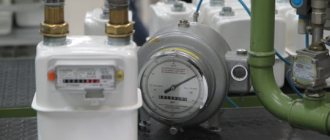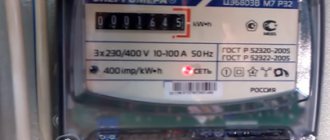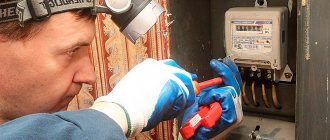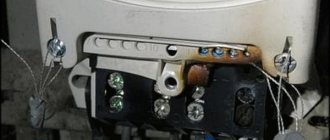Replacing an electric meter in a private home is a rare case, and yet it happens. This is mainly due to the renovation of the home itself, redevelopment of the interior, but also to the replacement of the old, obsolete meter with a new device. In our country, by decision of the Government it is prohibited to use electricity meters with accuracy class 2.5.
Also, replacing the device may be due to its improper appearance:
- depressurization;
- mechanical failures;
- damage to the viewing window.
In addition, modern meters “are able” to account for electricity at different tariffs, thereby allowing significant savings.
As experienced entrepreneurs say, if you save, you earn.
That is why it is worth knowing all the nuances and pitfalls associated with replacing an old device.
Regulatory framework
Attention! According to legal norms, in the territory of the Russian Federation, electricity metering devices in the cases specified in the law are subject to mandatory replacement. This rule has been in effect since 2009 with the entry into force of the Federal Law, which in 2014 was renamed the Federal Law “On Energy Saving and Energy Efficiency and on Amendments to Certain Legislative Acts of the Russian Federation.”
In addition to this regulatory legal act, a decree of the Government of the Russian Federation of 2006 is in force in the country, according to the standards of which electrical metering devices of class 2.5 are subject to mandatory dismantling.
The main reason for replacing electricity metering devices is that due to the increase in the number of household appliances, the volume of current passing through the metering units has increased.
Old-style devices (2.5) are not designed for such a current flow; therefore, they not only cease to show correct data, but also become sources of fires.
The need to install new types of meters is enshrined in Federal Law No. 102 - FZ of June 26, 2008, as well as in the provisions of GOST 6570 - 96.
The list of metering devices that are allowed for use is contained in the unified state register of measuring instruments.
The Housing Code of the Russian Federation contains standards for the division of responsibilities for the maintenance and maintenance of communications, including electric meters.
Delimitation of areas of responsibility
Electric meter device
Any replacement of an electric meter in a private house or apartment is accompanied by a division of responsibility for its reinstallation (simply, at whose expense this procedure is carried out). This means not only payment for installation, but also the cost of its repair, as well as subsequent maintenance.
Government Decree No. 491 of August 13, 2006 determines that any equipment located after entry into the house belongs to the area of responsibility of its owner. Since a typical electric meter is located after the input machine, it is considered the property of the owner of the house or apartment, who bears full responsibility for it (see photo below).
Meter location
In this regard, the question of at whose expense the meter should be serviced can be considered resolved.
Note! You have to pay the cost of replacing an electronic device “out of your own pocket” not only in cases where the meters are located within the apartment. The same approach is provided for devices installed on the landing or in special niches.
The costs of updating metering devices installed in those apartments that are privatized, as well as in cooperatives and suburban buildings, also “fall on the shoulders” of their owners.
It is possible to install metering devices (electricity meters) for free only in the following cases:
- During the events held as part of the campaign for the transition to a multi-tariff consumer payment regime;

Multi-tariff metering device
- If new electronic devices are installed during the process of replacing the electricity meter in a municipal apartment.
In certain situations, other options for exemption from payment may be considered.
The need to replace the meter
According to current legislation, the meter must be replaced if it is below class 2.5 and its service life is more than 16 years.
Notice! However, the law establishes additional cases in which the meter must be replaced regardless of its class and service life:
- the meter must be replaced if its state inspection period has expired;
- a meter that has defects in the housing or sight glass cannot be used;
- A counter whose mechanism does not work (for example, a scoreboard) cannot be used;
- meters that have not been checked by authorized persons are subject to dismantling;
- dismantling is carried out for meters whose error is more than 2.5%.
Remember, if the owner discovers one of the following defects in an electrical metering device, he must contact the authorized body with an application to remove the meter and install a new device.
Self-installation and connection of an electric meter
Replacing electric meters with your own hands is allowed, but not at all stages of the procedure. You can do the following on your own:
- dismantling the old device;
- preparing a place for a new device;
- installation of purchased equipment.
Attention! There is a risk that the subscriber will do something wrong, and will have to buy additional materials or involve specialists.
Management company employees perform the following functions:
- checking seals on metering devices;
- verification of new equipment;
- monitoring the correct installation of the device;
- sealing a new electric meter.
The device that is located inside the home is the property of the residents, therefore, regardless of who installs the meter, all testing services will be paid additionally.

Who should pay for the work?
So, the issue of payment for services has some nuances.
As a rule, such work must be paid for by the owner of the premises in which electrical appliances are installed:
- when the premises in which the meters are installed are privatized (it does not matter whether it is an apartment or a house);
- in relation to municipal facilities owned by the municipality or other authorized body, payment for the installation of meters is carried out at the expense of the municipality or authorized body.
When the residential premises are not privatized, and the metering units are located outside the residential premises (for example, placed in the entrance), then you should study the provisions of the agreement concluded between the management company and the residents of this house.
Attention! Our qualified lawyers will assist you free of charge and around the clock on any issues. Find out more here.
The difficulty in determining the payer in this case lies in the fact that the objects located on the landings are common property of the house.
If the agreement does not indicate the management company’s obligation to replace electrical appliances, then residents will need to independently resolve the issue of payment. When mass meter replacement is necessary, residents will most likely have to raise the issue of fundraising.
The cost of work associated with replacing devices depends on the region of residence of individuals, as well as on the company that will carry out the procedure. As a rule, it ranges from 1,000 to 2,000 rubles. Please note that the cost of the device itself is not included in this amount.
Instructions for removing and replacing the meter
Changing counting equipment installed in the entrance or on the street is accompanied by recommendations and supervision of a specialist. The master must have a certificate of assignment of electrical safety class 3. Replacement of the meter is carried out in the absence of voltage, in the presence of working tools, in compliance with safety precautions.
Among the available equipment, you must have a voltage indicator to check the corresponding value, screwdrivers, pliers, and electrical tape.
To correctly and safely replace an electricity meter, you must follow the instructions:
- Turn off the input circuit breaker to completely relieve the voltage.
- Open the cover with the wires, make sure there is no voltage at the terminals.
- Disconnect the wires under the cover.
- Unscrew the bolts to secure the equipment.
- Install the counter in reverse order according to the instructions.
After installing the device, you should check it for correct connection.
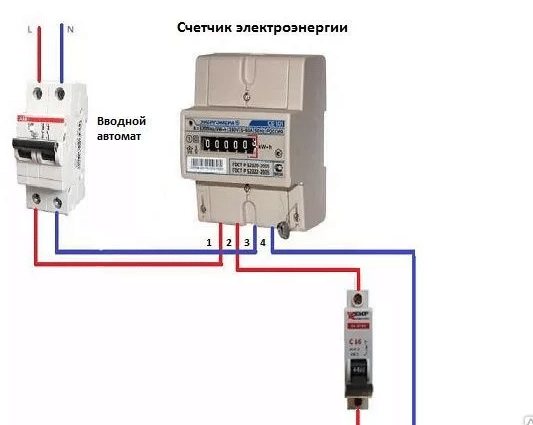
Replacing the meter is accompanied by compliance with safety precautions:
- It is unacceptable to leave bare wires, which can cause a short circuit and pose a threat to human life.
- Do not twist the wires; they are connected inside the shield by a terminal box.
- Turning on the meter is only permissible when the input machine is turned off.
- The metal housing must be grounded.
- Chaotic decomposition of wires is prohibited. They must be connected into a single bundle using dielectric bundles.
After turning on the introductory machine, the “Network” icon will light up. The remaining indicators should not work. When the input circuit breaker is turned off, the LED indicating the level of electricity consumed should not work. More information about the operation of a specific design can be found in the instructions for using the device.
The cost of replacing the meter by qualified craftsmen is about 2,000 rubles. The work includes removing the old and installing a new electricity metering device. If we count the costs of purchasing equipment, the user will pay about 4,000 - 5,000 rubles.
After visually checking the correct installation and operation of the meter, it is necessary to proceed with the design of the device. The event consists of several steps:
- Submitting an application to Mosenergosbyt with a request to seal and put the device into operation.
- Drawing up an acceptance report by the inspector indicating the type of meter and serial number. When installing yourself, you must check the correctness of the installation.
- Recording current readings, installing a seal on the electric meter.
Despite having independent knowledge and the ability to change electricity metering devices, it is recommended to invite professionals to conduct the event. They will make the task easier: they will bring their meter, remove it, replace it, and seal it.
Changing the meter in an apartment or private house yourself is a simple undertaking, but you can’t do it without contacting Energosbyt employees.
Rules for replacing an electric meter in a private house
Important! If the meter needs to be replaced, the following measures must be taken:
- First of all, you should obtain permission to replace the meter. To do this, you need to contact the company that supplies electricity. The application must include accurate information about the address of the house where the appliance needs to be replaced. The reason why the replacement must be made is also stated. After receiving the application, the company sends its specialist to inspect the device. Permission is given in writing. If the specialist makes a negative decision, then the reasons for such a decision must be indicated;
- After receiving permission, a meter is purchased. It is worth choosing a device in accordance with the recommendations given by the company supplying electricity;
- Next, the counter is installed. Installation can be carried out by any person who has access to electrical devices at least level 3. Electricians recommend inviting a company specialist. After the meter is installed, the person must be given a certificate signed by the person who installed the meter, as well as the seal of the organization that removed the old device.
Please note that independent dismantling without following the above procedure is not permitted.
Replacing the device in this case may be punishable by penalties, according to which from the day the seal on the old device is removed until the date of elimination of the unauthorized dismantling of the meter, electricity consumption will be the product of the sum of the powers of all devices in the house by their operating hours.
After installing the device, it must be accepted for operation, that is, the authorized body must establish that the device is working properly.
To do this, the owner will have to:
- submit an application to the authorized body;
- attach data about the old meter;
- submit technical documents about the new meter;
- submit a document that identifies the applicant;
- attach a document confirming ownership of the residential property.
When the meter is accepted, the specialist will put a seal on it.
The procedure for agreeing on the procedure
In order to change electrical equipment at a private facility, the supplier company is obliged to agree in advance on the date of the procedure with the consumer (by written notice or by telephone). Next, the owner of the house prepares all the necessary documentation for a scheduled check of the meter.
Upon arrival at the site, energy network employees must familiarize themselves with the device and make sure that there are no violations of its operation on the part of the user (if such violations are present, it is better to eliminate them before the arrival of the energy network workers, since this will result in a significant fine).
Only after this, upon replacement of the device, will it be possible to draw up an appropriate act to register the procedure in the state register.
The consumer will be able to purchase new equipment on site from the supplier company or from official manufacturers based on a certificate received from responsible employees of the energy network. These are the basic rules for coordinating all planned and unscheduled procedures related to changing the electric meter.
Required documents

In order to replace an old electricity meter, you should prepare the following documents:
- completed application;
- a document that confirms the identity of the owner;
- certificate of ownership of a residential property;
- technical documents for the device.
Watch the video. At whose expense are the metering devices installed:
Choosing an electricity meter
Currently, the market offers a wide range of meters, differing in technical properties and characteristics.
Device type and operating principle
An induction meter has a disk that, as it rotates, counts the amount of electricity consumed.
The advantages of such devices are their low cost and a long period between checks.
Electronic devices operate using microcircuits and semiconductors, so their readings are more accurate.
Number of phases
The following types of meters are distinguished:
- single-phase;
- three-phase.
Electricians note that some categories of three-phase meters can be used in any network. Three meters, which are single-phase, can also be connected to a three-phase network. Then each indicator is taken into account separately.
Which counter should I choose?
It is recommended to ask Energosbyt employees this question, because it is important to choose a device that will suit the network parameters. In order to understand this issue in more detail, we will look at the types of electricity meters.
Table 1. Types of electricity meters
| View | Description |
| Single phase | Such devices are installed in apartments, private houses, and small office spaces. If there is a voltage of 220 V, the power of such networks will be up to 6 kW. Therefore, in order to understand the maximum current value for which the meter is calculated, you should remember that each kW of power is equal to 4.5 A. Next, all that remains is to multiply these values. You can find the exact characteristics of the rated and maximum current on the front panel of the meters, so you should choose a single-phase meter when it suits the network parameters. |
| Three-phase | Such devices are often installed in villages where there are many cottages, because electricity can only be supplied there through a three-phase system. In addition, such equipment is often installed at production facilities. In order to select a suitable device, it is necessary to take into account that it must have the following qualities: 1. The device must include an internal tarifficator, which will take into account the date and time for changing tariffs. 2. A power profile is required that will monitor maximum power over time periods. 3. There should be a log of power surges, power outages and other events. 4. Communication must be carried out through a special program with the main PC. |
| Two-tariff | Sometimes electricity is supplied at different rates. So, during the day the payment is higher, and in the evening and at night it is lower. Such conditions are beneficial for people who are accustomed to nightlife. |
Installation Requirements
Before installing a new device, you need to take care of preparing the installation site for it.
The operating period of the electric meter can be affected by temperature, humidity, and vibration in the room.
Please note! In this regard, we can highlight the following list of requirements that apply to the meter installation procedure:
- If the new device is to be installed indoors, the air in it must be dry. When it comes to installing the device outdoors, a box must be attached to the wall, into which the device itself is subsequently attached;
- when choosing a location for installing the device, you should remember that it must be located in such a way that a specialist has unhindered access to it;
- the electric meter is installed on a rigid surface that should not vibrate or move;
- it is allowed to install the meter on a shield made of wood, metal, plastic;
- the shield must be installed vertically;
- the device is placed on the wall no higher than 170 cm from the floor;
- installation cannot be carried out if the device deviates more than 1 degree, since otherwise the meter may not work correctly. This is especially true for induction models;
- remember, the wires must be stripped at least 2 cm;
- After installing the device, a specialist must ground the area;
- The device must be equipped with automatic switches that will operate, for example, in the event of a fire.
Installation process
The entire procedure for replacing an electricity meter is quite simple, but requires certain knowledge in the field of electricity and experience in such work. The main aspect of the success of a started business is the purchase of a quality device.
Device selection
Today, two types of meters are produced: electronic and induction. The latter provide two coils. Their magnetic field rotates a special disk, which drives a mechanism for calculating the electricity used. The main advantages of an induction device are the following:
- durability (the meter can work for 15 years or more);
- high reliability;
- simplicity of design.
Electronic devices count the electricity used using microcircuits or semiconductors. The meters also have built-in voltage sensors that transmit data on the amount of electricity consumed. These devices are much more expensive and work less than induction devices, but have a number of important advantages:
- give more accurate readings;
- have the possibility of multi-tariff accounting;
- convenient for taking readings;
- virtually eliminate the possibility of electricity theft.
In addition, meters are divided into single-phase and three-phase. The former are used in private houses and apartments, and the latter in industrial enterprises, as well as in various municipal institutions.
Three-phase metering devices are much more informative and have a number of positive characteristics:
- Availability of an internal rater. The device independently keeps track of time and manages tariff transitions.
- The ability to determine the maximum and minimum power indicators for the required period.
- Built-in communication interface. The meter transmits readings to the communication center at the right time and does this without human help.
- Saving data on voltage readings, surges, power outages.
Having chosen the most suitable option, you need to check it according to several more criteria. The selected device can only be installed if it fully complies with them.
Important parameters:
- Accuracy class, which allows you to determine the degree of error of the measurements.
- Connection method. If the device is used with light loads, it is best to connect it directly. For large values, the meter is connected via a transformer.
- Number of tariffs. In some countries, electricity costs much less at night than during the day. Therefore, you can choose two-tariff meters and reduce financial costs.
- Voltage class.
Installation requirements
To replace the electric meter in an apartment, you must comply with the installation requirements. They consist of proper preparation of the room and installation site. Among the most important are the following:
- The living space must be dry.
- Installation is allowed at room temperatures from +20° to +40°C.
- The surface of the attachment point must be rigid and not vibrate under the influence of external factors.
- The meter can be mounted on wooden, metal or plastic panels.
- The device can only be installed vertically.
- The mounting height depends on the height of the apartment owner (it is best to place the meter at eye level).
- The tilt angle of the device should not exceed 1 degree.
- Circuit breakers must be provided.
Replacing a single-phase device
To install such a meter, you must purchase all the components from a specialized store. If you don’t want to buy them separately, then you can look for a ready-made electrical panel.
To carry out the work you will need:
- counter;
- din rail;
- panel for placing instruments (made of wood, metal or plastic);
- circuit breakers;
- wiring with a diameter of at least 3 mm;
- stainless steel screws.
It is very important to prepare all the necessary materials in advance. This will allow you not to be distracted while working and not to look for this or that item. Sequence of operations:
- All devices are located in the panel. This procedure will allow you to select the most effective location option.
- Markings are applied for the DIN rail and electricity meter.
- The components are securely fixed to the wall.
- Automatic switches are installed on the rail.
- After this, the phase is displayed on them.
- The wire is cut and stripped of insulating material.
- Then the terminal is inserted, and the structure is fixed with fastening materials.
- Circuit breakers are connected to the system.
- To output zero, take a wire of any contrasting color and measure the required length from the copper plate to the meter.
- The wires are carefully stripped and secured on both sides.
- At the next stage, the shield is mounted. For this, the necessary markings are carried out.
- Holes are drilled in the wall and the structure is screwed using self-tapping screws.
- Grounding is installed.
Three-phase device
Such meters are installed only in cases where there are large volumes of electricity consumption. At the output they provide 380 V or 220 V, which is the optimal indicator for most industrial equipment. In addition, three-phase devices prevent any voltage surges.
The installation process for a new device looks like this:
- The power wire has three phases, ground and neutral, which is connected to the electrical panel.
- The phase is connected to the first, third and fifth contact.
- The device is tested and errors made are identified.
- They are eliminated until all wires are connected correctly.
- Electricity is removed from the remaining free contacts, and zero falls on the seventh and eighth.
- The grounding is attached to a special bus, and the zero is taken to the ground.
Replacing an old meter with a new one is a long process, which is accompanied by the collection of necessary documents and permits. By choosing the right equipment and following the recommendations of professionals, you can significantly simplify the work and complete it in a minimum amount of time, and the new device will effectively record energy consumption over a long period of time.
Sample certificate for replacing an electricity meter
After installing the device, a specialist must fill out an instrument installation certificate.
The act is drawn up in two copies and signed by both the owner of the premises and the person who installed the device.
The act contains the following list of data:
- the location where the meter was installed;
- the address where the premises where the meter was installed is located;
- data of the meter that was removed (its type, number, year of manufacture, readings);
- new counter data;
- installation date information;
- information about the person who installed the new meter.




